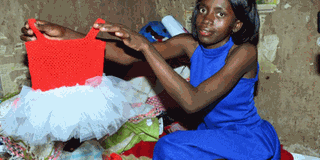HIV/Aids stigma: The unwon battle

Victim. Ms Sylvia Nalukwago shows off some of her handcrafts that she makes to earn a living. She was one time expelled from school because of her status. PHOTO BY MICHAEL KAKUMIRIZI
What you need to know:
- Deadly. Stigma is a serious stumbling block and hampers the battle against the HIV/Aids scourge.
- Nalukwago’s experience underlines how stigma is a serious stumbling block and hampers the battle against the HIV/Aids scourge, which currently affects a total of 1.3 million people in the country.
For all the 26 years that Sylvia Nalukwago has lived with HIV/Aids, she cannot forget the day in her Senior Five-second term when she was expelled from school because of her status.
“The headmistress found me with another colleague, who was also HIV-positive in the dormitory during class time because we were not feeling well,” Nalukwago says.
She ordered us to pack our stuff and leave the school, saying she did not have a hospital at the school as we were often sick.
“We first thought she was joking, but she came back with a cane and threw us out and asked us never to return to her school,” Nalukwago narrates further, saying she had to switch to a different school, moreover in a candidate class, which affected her performance.
“At school, my classmates used to undermine me because I was so small. In Senior One, they used to call me “small atom,” Nalukwago recollects.
The stigma was even worse coming from family when she was disowned by her father when she was in her Senior Six vacation, saying he was also tired of taking care of her given her sickly condition.
“I was depressed and even withdrew from ARVs, which I had started in 2011, for nine months until I was put on line two of the medication,” she says.
Nalukwago’s experience underlines how stigma is a serious stumbling block and hampers the battle against the HIV/Aids scourge, which currently affects a total of 1.3 million people in the country.
Experts define HIV-related stigma and discrimination as the devaluation of people either living or associated with HIV/Aids.
Ms Stella Kentutsi, the executive director of the National Forum of Persons Living with HIV/Aids Networks in Uganda (NAFOPHANU), says although community stigma against people living with HIV/Aids is reducing, stigma at an individual level is still high (internal stigma).
“Internal stigma where the individual is feeling suicidal, are the ones which affect how a person will be able to access the services,” Ms Kentutsi says. “People are still considering it [HIV] as a death sentence,” she adds.
Ms Kentutsi also notes that community mobilisation seems to have been left out, where sensitising people has gone so low and makes structural issues a challenge.
Ms Kentutsi’s assertion is confirmed by the 2019 HIV stigma index report that was released on Monday.
Although stigma against people living with external forms of HIV/Aids, including exclusion from social gatherings, physical and verbal harassment have comparatively reduced from 50 per cent in 2013 to the current 24 per cent, the report further showed that “internal stigma, individual feelings such as low self-confidence that often lead to negative actions, have remained high among people living with HIV/Aids.”
Ms Barbara Kemigisa, a youth living with HIV/Aids and founder of PILL Power- Uganda, an HIV/Aids-related non-government organisation, also observes that stigma is more deadly than HIV/Aids itself as it affects one’s ability to access services.
Having been treated as an outcast by both the community and family, Nalukwago says she nearly committed suicide.
From her experience, Ms Kemigisa says stigma has remained a problem in the country because there is no support system at community level yet even at the facility level where there is psychosocial support, the patient only has a few minutes with a health worker when patients go to refill their medicine due to the overwhelming numbers.
“I have seen [HIV/Aids patients] get back on their feet and fit. I also have a 10-year-old who is HIV-positive and now a motivational speaker, but the problem comes when we wait for children to grow up and at that time, there is nothing you can do,” Ms Kemigisa states.
Other HIV/Aids activists have also advised that government has to go back at community level to fight stigma if its programmes are to be effective, including achieving the 90-90-90 Unaids goals.
Depression
A study released by the Uganda Virus Research Institute (UVRI) in November indicates that the numerous HIV/Aids-related psychosocial problems, including stigma, make patients prone to depression yet they are not able to detect and report the condition to health workers.
The same stigma also barred many people from reporting depression to health workers, which leads to poor treatment outcomes
The HIV+D Study also found that using Health Activity Programme (HAP) depression therapy, which involves lay counselors talking to patients about their social-economic challenges like stigma and thoughts of living with the disease for life, is a cost-effective method.
Although the government in 2016 released new guidelines for the treatment of HIV, calling for the assessment and management of depression as an integral part of HIV care programmes, the study showed that they are not implemented in most of the health facilities.
The study also found that about 8-30 per cent of people living with HIV have depression depending on the location, with northern Uganda found to have very high rates assumed to be arising from the effects of the 20-year Lords Resistance Army insurgency.
Dr Nelson Musoba, the director-general of the Uganda Aids Commission, the national organisation which oversees the strategy to combat HIV/Aids in the country, agrees, saying continued stigma against people living with HIV/Aids is responsible for the high numbers of the scourge-related deaths.
He says, as a result, many people seek treatment late when their immunity has already weakened.
“Sometimes you have TB and cancers because there are very many cancers and the opportunistic infections that come with HIV. So it starts with stigma, they [patients] don’t seek treatment on time, sometimes they are taking half of the treatment or not on time,” Dr Musoba states.
“We have about 25,000 related deaths every year as of 2018, but there has been a massive reduction for both new infections and Aids related deaths,” he adds.
Although Nalukwago is now back on her feet and leaves a positive life after getting psychosocial support from different organisations, many HIV/Aids patients have not had that opportunity and have ended up dying before the virus itself takes a toll.



